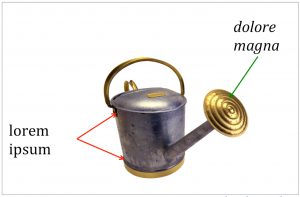The design process is often a source of misunderstanding and friction. We have brought together concepts and frameworks from various fields that provide ways of helping to make design work more smoothly, and to help produce designs that work well for everyone involved.
The image below shows an example.

This image shows design rationale annotation. In this example, the arrows show some of the feedback about a design, with the two red arrows from the “lorem ipsum” comment pointing to bad features of the design, and the green arrow from “dolore magna” pointing to a good feature. This approach can be used to bring together feedback from experts and from potential users, to identify which features can be kept as-is, and which need to be reconsidered. Different colours, thicknesses and types of line (e.g. dotted or dashed) can be used to show the nature of the feedback (good, bad, ambivalent etc) at a glance.
User centred and person centred design involve finding out what users actually want and need, as opposed to e.g. focusing on cost or ease of manufacture, or making assumptions about what they want and need.
Design rationale involves systematically working through the reasons for each feature in a design. This article illustrates the key concepts in using this approach.
Liking, disliking and novelty in design. This post unpacks some of the concepts involved in people’s reactions to designs, and shows ways of handling those concepts systematically.
Useful concepts for understanding design. Here we describe some concepts from outside the usual design literature that provide useful new ways of thinking about design.
Idea generation is much more effective and efficient when it uses systematic approaches rather than unstructured group “brainstorming” sessions. This article describes some systematic approaches.
Iterative mockup prototyping is a simple, practical and effective way of systematically improving a design before going into manufacture. It’s taken for granted in some fields, but hardly known in others.